By: Nancy Stratman, NDA Archivist
Since its establishment in 1906 as the premier girls’ Catholic high school in Northern Kentucky, Notre Dame Academy has been known for its founding principles of excellent academic standards, community service and leadership values. A fourth principle, perhaps most recognized through its rich traditions, is the firm foundation of religious values. Inherent in the fabric of the Sisters of Notre Dame, the strong devotion and dedication to Our Mother, the Virgin Mary, provided the groundwork for years of traditions and celebrations honoring the Virgin Mary as a role model for the students at NDA. As the first high school principal, Sr. Mary Agnetis relied on her own faith and her concern as an educator to form young teenagers into the ideal charming, cultured, Mary-like woman. “Sister has always maintained that her greatest challenge was to so indoctrinate the young mind with the ideals of Mary that a love and admiration for Mary would make them want to imitate her.” (Reflections from her Diamond Jubilee). And, so they did. “Every student who attended NDA from 1906 until well into the 1960s has gone away with a part of Sister’s personality, for these – the ideal of the Virgin Mary, the spirituality of vigorously living the Mass, the culture of the classics and the refinement of true Christian womanly living – are as much a part of the academy curriculum as they are of Sr. Mary Agnetis’s life.” (KY Post, Jack Wessling, 1960)
With the move to the new campus on Hilton Dr. in October of 1963, the senior class was tasked with keeping the varied traditions of honoring Mary intact, as well as developing new opportunities for students to remember and honor Mary, Our Mother. “I remember that the focus of my opening day speech was that, as seniors, it was our responsibility to see that the Notre Dame Academy spirit on Fifth Street had to make it to the new school in Park Hills.” (Mary Ann Egi Muck, 64)
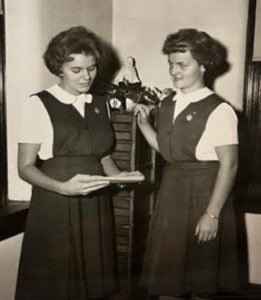
Mary Ann Egi and Barbara Rauf, Fall, 1963
Wearing their blue sleeveless jumpers with their St. Julie medal proudly displayed on their bodice, 94 senior class members were the first to venture into this new world, many anxious as to what the school year would be like. Fears were calmed when the familiar statue of Mary, Our Mother stood amidst the spacious lobby and welcomed them as she had always done on 5th Street. Each student quickly stepped into the old tradition of bowing her head respectfully and greeting Our Lady with the familiar prayer of welcome, “O Mary, to Thee I give the lily of my heart. Be thou its guardian forever”. At their first Mass together on the new campus, each student stood in solidarity and petitioned Our Lady for her grace and guidance. “O Mary, bless our new school. Let each room be aglow with the spirit of love, so that we who dwell within its walls may become more pleasing to your son, Jesus Christ our Lord.” (prayer from opening Mass, 1963)
Since that morning, over 60 years ago, many of the events which venerated and celebrated the Virgin Mother have continued on at Notre Dame Academy. Although a few have changed or are no longer practiced, the current students have a long heritage of these traditions on which to base their current practices.
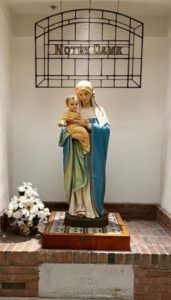
Traditions
The daily greeting of Our Lady and her Son with a bow and “Ave Jesu et Maria” is a Notre Dame tradition as old as Notre Dame itself. This statue of Mary, holding the infant Jesus welcomed each student into Notre Dame Academy on 5th Street and was later transferred to a place on honor in Heritage Hall on the new Campus.
“We lovingly bowed every time we passed the Blessed Mother’s statue in the hallway near the entrance.” (Mildred Ziegler Zins, 1937) “One of my fondest memories was saying ‘good morning’ to the Blessed Mother, who was the first thing we saw as we entered the Academy building. I learned it was an honor and a privilege to be a “Notre Dame Girl”, one of Our Lady’s”. (Mary Huwel Bayless, 1938) “I didn’t know that Mary should be so much honored and loved and imitated, until I came to school here”. (The Gavel, 1960)
“To this day, I never leave church or a classroom or pass a statue of Mary without turning and bowing slightly. A sign of respect I never forget” (Rosemarie Schwegmann Wessel, 1938)
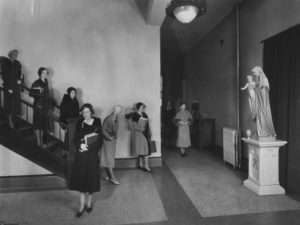
On the new campus, a statue of Mary can be found at every entrance to the building, and in every classroom so that she still offers the first “Hello” to all who enter.
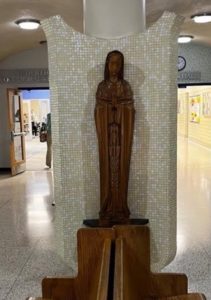
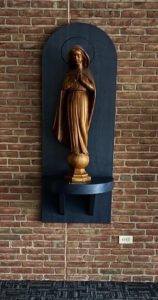
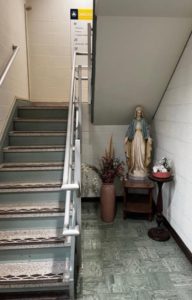
(inside the front lobby) (at the theatre entrance) (inside the rear entrance)
Mary’s statue was always a gathering place for students as they celebrated special events throughout the school year; celebrating new uniforms, admiring their class rings, praying for peace during war times or simply saying thanks for her blessings.
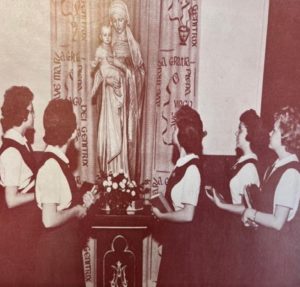
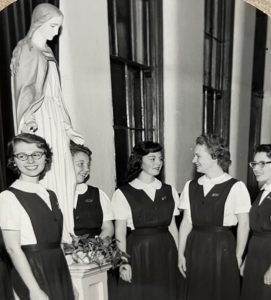
(praying before exams) (admiring their new uniforms)
On the last day of semester exams in December, students would gather around Mary’s statue, located just inside the main door on 5th Street to celebrate the upcoming holiday. Known as one of the happiest “Mary” traditions at Notre Dame, students from each grade level gathered to sing Christmas carols during the lunch hour. Old familiar favorites and modern songs as well were part of the program.
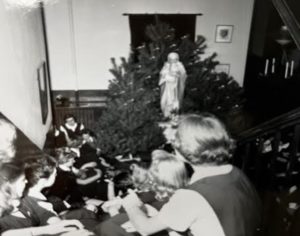
“I will always remember my freshman Christmas at NDA. We were in the old school and it was a gloomy day and we came down the marble stairs and we gathered around the Blessed Mother statue and sang Christmas songs. The hall lights were off and just the blue Christmas lights were glowing. The smell of the pine trees combined with the marble and wood is a picture I will always remember.” (Margie Frommeyer Kaufman, 1958)
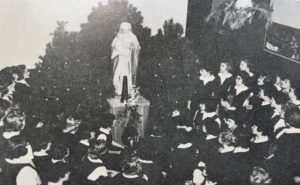
Throughout the years, the guidance and protection of Mary was celebrated as Student Council and various other clubs were inducted at the beginning of each academic year.
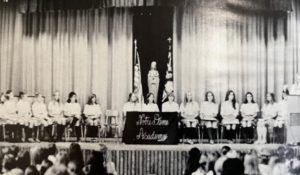
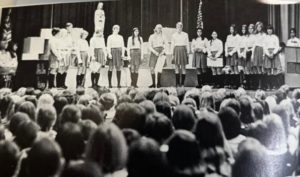
There were also several clubs that paved the way for students to promote and celebrate the influence of Mary in their lives, including the Legion of Mary and Mary’s Committee. According to the 1964 student handbook, the Legion of Mary was based on a world-wide association of Catholics, “who pledged themselves into a Legion for service in the warfare which is constantly waged by the Church against the forces of evil.” (NDA student handbook, 1964) The club was started in the fall of 1958, and quickly became a way of life for its members. “The object of the Legion is to work in the name of Mary for her honor and glory, thereby gaining eternal salvation for themselves and for so many who have come into or back to the faith through the Legionnaires’ apostolic work.” (The Gavel, Summer 1959) Through the Diocese of Covington, the Legion was divided into three groups of membership: the Senior Active Members worked primarily with the general public, the Junior Active Members who worked primarily in the schools and the Auxiliary Members who regularly offered prayers through the daily recitation of the rosary. At NDA the work of the Junior Active members centered around chapel duty, the recitation of the rosary at school on a daily basis, during special assemblies and a weekly broadcast at a local radio station and announcements and promotions for the celebration of the various feast days of the Blessed Virgin.
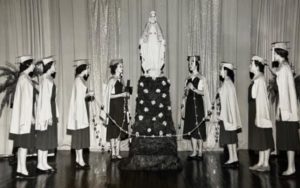
Outside of the school day, Mary’s Legionnaires participated in community projects including preparing bandages for mission lands, visiting patients at rest homes and assisting with the children at St. John’s Children’s Home. Members of the Legion of Mary also sponsored the yearly Marian Test which was given to select the students who would serve as Mary’s Maids at the annual May Crowning. Due to dwindling participation, the Legion of Mary club was no longer offered at NDA after the 1981-82 academic year.
A second club which focused on Mary was Our Lady’s Committee, which for most years was a part of the Ministry Committee of Student Council. “During the month of October, Our Lady’s Committee prompted the praying of the daily rosary. Connected with the campaign was a display on the main bulletin board on which the students placed blue pennants behind the banner of Our Lady to signify their promise to pray the rosary daily.” (The Gavel, Nov 1955)
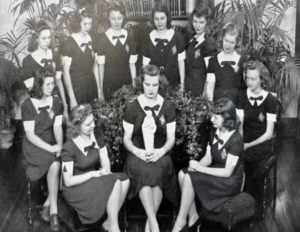
DECEMBER
As early as the 1920s, the Gavel describes a yearly tradition of celebrating the importance of Christmas at NDA first as a religious holy day and then as a commercial holiday. Throughout the school, each statue of Mary was decorated for Christmas.
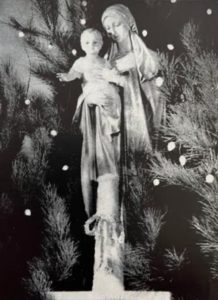
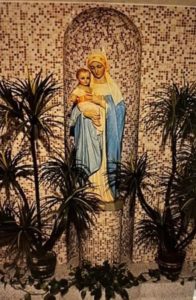
For many years, each class would participate in an Advent pageant which would depict aspects of Mary’s life, especially centering on the birth of Our Lord and through many forms of artistic expression, convey the relevance of Mary into our present world. “The sophomore Advent program struck the most proper note for the coming of Christ at Christmas. Choral recitations, interpretative dance and pantomimes recalled the ancient promises and prophecies; a modern touch was produced by the longings of the world today – the coming of Christ in all hearts, especially those behind the iron and bamboo curtains.” (The Gavel, Winter 1959-60)
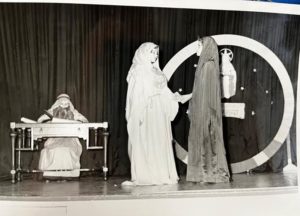
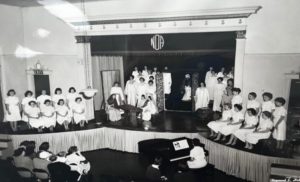
After mid-term exams were finished, the student body would gather for a day of festivities to celebrate the upcoming holidays. These festivities included choral selections, performances by the NDA band and skits followed by a visit from Santa and his elves.

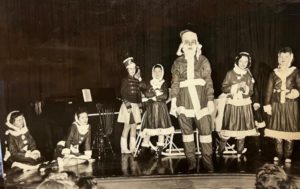 .
.
The primary celebration however, in December centered around the Feast of the Immaculate Conception on December 8. Although the details surrounding this celebration varied somewhat every year, key elements including novenas of preparation, Mass (always held on December 8, unless school was not in session and then it was moved to either within the school day on December 7 or during the evening), the blessing and distribution of the Miraculous Medal and a celebratory breakfast were carried forth every year. “In preparation for the Feast of the Immaculate Conception, students gathered in chapel every morning the week preceding the Feast to pray together. Each student also made special offerings and petitions to offer to Mary at Mass. At the offertory, a representative from each homeroom brought the offerings and petitions of the students to the altar.” (The Gavel, January 1966). “Entering the chapel, we saw the chest containing the petitions and promises made to Our Lady by each student. The altar was beautifully decorated with flowers purchased from the offerings made by each student – their gift to Mary. After Holy Mass, the entire student body assembled in the cafeteria and gym for a feast-day breakfast. After breakfast, the freshmen returned to Chapel and were enrolled in the Association of the Miraculous Medal. A senior privilege on this feast day is receiving a silver medal and chain, which they will wear constantly as a token of love for Mary. All of the girls will likewise receive a picture of the Immaculate Conception as a souvenir of the feast.” (The Gavel, December 1943) “I recall the celebration of the Immaculate Conception. We wore the blue and gold capes and caps, and all went to Mass. Then we went down to the cafeteria where the tables were all decorated- tables of four. Then we were served a lovely breakfast with a souvenir for everyone – a holy card- and then we were dismissed for the day.” (Claire Bassman Seidenfaden,1940)
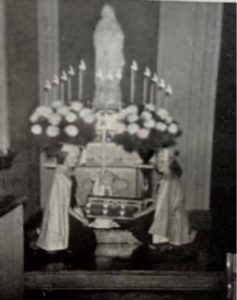
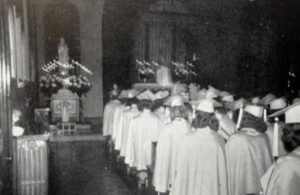
In 2006, as the school celebrated its 100th anniversary, the tradition of morning Mass and breakfast was revived by principal Sr. Elaine Winter, SND. The entire student body, faculty and staff were bused to the Cathedral Basilica in Covington to celebrate the feast of the Immaculate Conception, after which they returned to school and enjoyed a celebratory breakfast, after which students and faculty were dismissed for the day.
May, the month dedicated to Our Lady
As the academic year drew to a close each year, the importance of Mary in the lives of each of the NDA students again became very apparent with a variety of activities addressing the centrality of Mary in their lives. Often, the activities included visual arts displays, daily prayer, student recitation of the rosary broadcast over a local radio station and formal assemblies. “Mary, as usual, takes the spotlight during the sweet, pleasant month of May. This year the Committee of Our Lady conducted two contests in order to get the students to vie with one another in honoring their Queen. First, inspiring May altars decked with gorgeous flowers appeared in each classroom. The award for having the most beautiful went to Junior A. The second contest was open to each individual student.
Four bulletin boards were converted into miniature stages where Our Lady was placed in the spotlight-in a different scene each day. The students were to identify the feast represented, or the title under which Our Lady was honored and the date. Shirley Sunnenberg, Freshman D, won the coveted prize in this contest.” (The Gavel, May-June 1946) Even the alumnae would return to campus, often during difficult national times, to pray for Our Lady’s intervention. “The ever-fresh bouquet adorning the statue of Our Lady in the east lobby is a reminder that the alumnae members are keeping their pledge of having a perpetual bouquet before Mary as a silent and fragrant petition for world peace. The schedule for supplying the flowers is so arranged that every member has a chance to present a nosegay to Mary.” (The Gavel, December 1943)
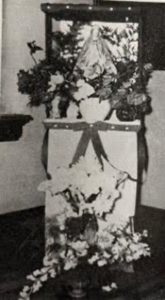
However, when reminiscing about their days at NDA, most alumnae agree that the two biggest events dedicated to Mary were May Crowning and the prom.
Typically, preparations for May Crowning began in March with the selection of Mary’s Court. This selection was completed differently throughout the years. During the earliest years of the school, students would compile a booklet depicting events in Mary’s life. “Rosemary Fedders, a member of the Legion of Mary, was Mary’s Maid of Honor, assisted by 4 attendants. Rosemary’s book was the winning entry in the contest sponsored by the Legion of Mary. Rosemary devoted the first pages of her book to a history of the Litany of Loretto, and on the following pages under each invocation, she had an original verse describing each title.” (The Gavel, May 1956) For many years, juniors and seniors gathered together to test their knowledge of Mary’s life and her role in the Catholic church. The student who scored the highest was awarded the privilege of crowning the Virgin Mary. Her attendants were the next two highest scorers from both the senior and junior classes. “The primary purpose of the contest is to challenge the students to increase their knowledge of and love of the Virgin Mary. As a secondary purpose, the Legion is using the contest to determine Mary’s Maid and her attendants for the May Crowning ceremony. Each day during the contest students could be found searching through numerous books and periodicals for the answers to contest questions. They hoped to gain the coveted honor of placing the crown on Mary’s head.” (The Gavel, 1962) At times, a combination of criteria was used. “Mary’s Maid, senior Jacqueline McMurray had the honor of crowning the Blessed Mother. Jackie merited this honor by winning the annual Marian Contest. This contest consisted of three separate parts, the last entry of which was a book on the Sorrows of Mary containing 18 original poems about Mary and May.” (The Gavel, Summer, 1962) After moving to the new campus, the test and booklet were generally replaced by a written essay, which was open to just seniors. “This year, however, the honor of being Mary’s Maid was limited to seniors. She was chosen on the basis of written essay explaining why she wanted to crown Our Blessed Mother and also on the opinions of other seniors who thought that a certain girl should merit this privilege. The final choice was based on a drawing. (The Gavel, 1965)
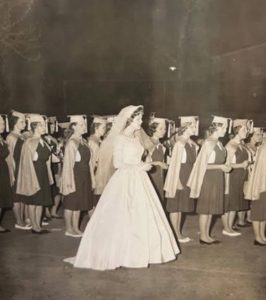
For the first 50 or so years, the May Crowning mass was celebrated in the NDA school chapel. The entire student body, along with members of Mary’s Court would gather outside of the school and process around the building into the chapel, or when the weather cooperated, into the courtyard. Mary’s Maid would be attired in a long white gown, while her attendants wore formal gowns of various colors. “The May procession around the Music House, through the courtyard and into the chapel for the crowning of the Blessed Virgin has always been one of my most favorite memories”. (Marcella Ziegler Kerl, 1939)
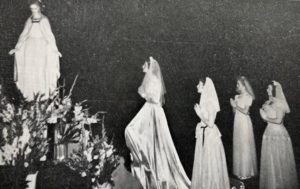 .
. 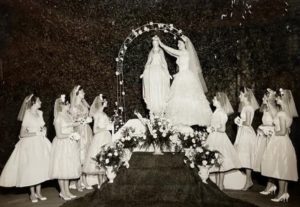
May Crowning, 1942 May Crowning, 1960
In 1962, however, the tradition changed. “This year NDA’s traditional May Crowning was held in familiar yet new surroundings – Mother of God Church. Mary’s Maid was chosen from the highest scoring senior on the Marian test. She was assisted by girls who rated the next highest from each grade level. All others who participated in the contest were included as a special Guard of Honor. Each of these 110 students wore blue caps and capes and carried a carnation to Our Lady’s altar. The rest of the student body participated in the ceremony by entering the Church with a lighted candle, saying the Rosary. At the conclusion of the Rosary, Monsignor Elsaesser delivered a short homily on Mary’s place in a student’s life. The Marian Devotion was followed by Benediction with the Blessed Sacrament.” (The Gavel, Summer 1962)
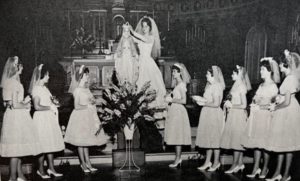
For the first couple of years on the new campus, May Crowning continued much as it had on the 5th Street campus. Mary’s Maid continued to wear the traditional long white dress with her court attired in formal dress and the ceremony, itself, was celebrated in the evening hours.
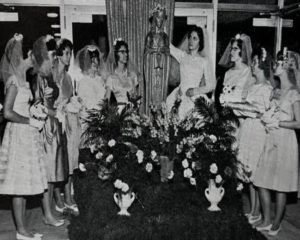
“The sun was setting, but darkness did not come! Two small flickers of light appeared, then two more and within minutes NDA was half encircled by Notre Dame Academy girls, each bearing a small candle. Yes, it was the traditional candlelight procession beginning the annual May Crowning. On the evening of May 6th, at 7:30 p.m., the procession began with the banner bearer and attendants in the lead, followed by the student body carrying candles. Closely behind was the Legion of Mary and the special guard, which was composed of two girls chosen to represent each homeroom. They were followed by Mary’s Maid and her attendants. Also, this year only one attendant was allowed to represent her class or praesidium. The manner of choosing these girls and those who made up the special guard was left up to the individual homerooms or classes.” (The Gavel, May 1965)
In 1970, the May Crowning ceremony took a more modern twist. “May Crowning took a somewhat different form this year. In place of the traditional evening ceremony of crowning Mary, the singing and praying were held after school on Tuesday afternoon from 3:30-4:30 p.m. This year’s theme was a Tribute to Mary for Peace. The ceremony began with a March for Peace. Students, in their school uniforms, began a march from the cafeteria, proceeded all around the grounds of St. Joseph Heights, over the parking lot and ended before the statue of Mary in the circle. In keeping with the plea for peace each girl was asked to present a personal petition with a flower she had made, symbolizing her personal dedication to Mary. These gifts were collected at Mary’s feet and there the petitions were burned.” (The Gavel, June 1970)

Since the 1990s, May Crowning has been held as part of the last regularly scheduled school Mass. Mary’s Maid and her court are generally seniors who are chosen based on a written essay.
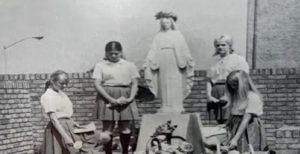
Even in the year 2020, when the school was closed because of the pandemic, Molly Kleier, the student who had been chosen earlier to crown Mary had there been a traditional Mass that year, crowned the statue of Mary on the front patio so that the long tradition would continue. In more recent years, the tradition of handing out the Miraculous Medal of Mary has been revived and is now given to all freshmen, new students and new faculty members during this mass.
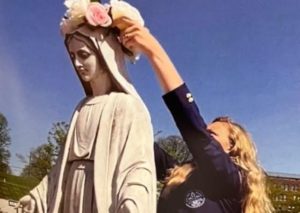
From the first official prom in the 1930s until well into the 1960s, the Virgin Mary was the central figure at each Notre Dame Academy prom. All attendees and their dates would enter the venue single file and process into the room and gather before the statue of the Virgin Mary. The prom princess and her court, accompanied by their dates would encircle the statue and as the entire gathering sang “Mother Beloved”, Mary was crowned as “queen” of the prom. “Prom Princess, Janet Shummer, crowned May while strains of Mother Beloved were sung by all in attendance: “Mother Beloved, of God and of men, here at your feet, faithful, we meet. Comrades of Mary, redeemed by your Son, keep us who love you – in all things, one.”
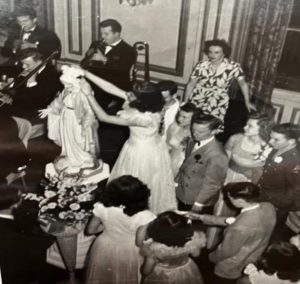
The theme was “The Sand and The Sea”, so the 1st thing you saw when entering Summit Hills Country Club on May 6th was a statue of Our Lady, Queen of the Sea. Glittering stars were suspended from the lights and formed a background for Mary. (The Gavel, Spring 1955)
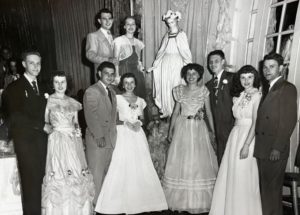
During the early 1970s, the tradition of crowning Mary at the prom came to an end. Instead, the school celebrated a Mass on the day of the prom and dedicated the dance to Mary’s honor, asking her blessings on their special night. Although the tradition of honoring Mary at the prom was discontinued, the term “prom princess”, not prom queen is still used. To this day, students elect a “prom princess” at Notre Dame Academy, not a prom queen, for Mary has always reigned as Queen at NDA.
As the school year came to a close, Mary was once again honored during the graduation ceremonies. During the earliest years of the high school, the graduation ceremonies took place at the end of term in the high school auditorium. Mary was given a place of honor center stage with the graduates. The remainder of the student body attended wearing their honor capes and mortar boards.
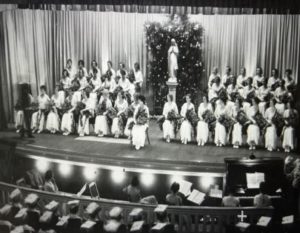
From the 1940s and continuing well into the 1990s, the conferring of diplomas was part of the Graduation Mass, and for many years was held at Mother of God Church, due to its proximity to the 5th street campus. As the graduates processed in, flowers would be placed at the statue of Mary with prayers, asking for spiritual guidance for each of the graduates. “Graduation was held on May 31st, the Feast of the Queenship of Mary. After entering Mother of God Church, all graduates knelt to recite a special prayer to Our Lady, which had been composed by a faculty member many years ago. Afterwards, the entire student body joined the seniors in singing “Queen of Peace”. (The Gavel, 1955)
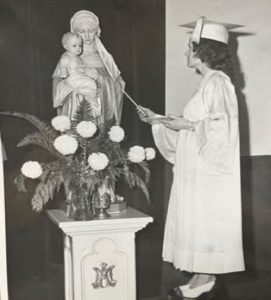
For the past couple of decades, graduation ceremonies have been held separate from a Baccalaureate Mass. The tradition of honoring Mary however, continues as a statue of Mary, decorated with bouquets of red roses, resides at the center of the dais and overlooks each graduate as she receives her diploma.
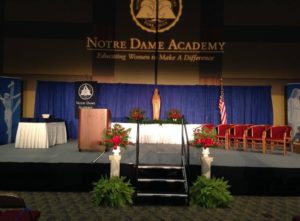
While many of the practices honoring Our Blessed Lady have changed or no longer exist at Notre Dame Academy, the tradition of honoring Our Lady continues in new forms. As mentioned, the selection of members for the May Crowning court and the title of “queen of the prom” have continued from the earliest days. In addition, morning recitation of the rosary is offered several days during the school week. An alumnae rosary is offered once a month. Since 2010, the sophomore class retreat is devoted to the role of Mary in the lives of the students and is held during the month of December. During this retreat, every sophomore receives a rosary made of blue and yellow beads created by an alumnae benefactor. For Notre Dame Academy, dedicated to the Virgin Mary, the traditions of honoring Our Lady remain part of the fundamental spirit of NDA for each student. In her essay submitted for the honor of crowning Mary in 2015, Brittany White wrote “Mary is a beautiful role model for all women. She is graceful, strong, courageous, faith-filled; everything a woman should strive to be. As young girls it is important for us to have role models so rooted in faith and goodness. The beauty of who women were meant to be is found through Mary, for she is the “New Eve”, she is the woman who has set the standard for all other women. I strive to gain the beauty that Mary holds, her grace is so captivating and her role as a mother is so inspiring. This school dedicated to Mary has made me realize the importance of her “Yes”. She is my spiritual mother and helps me to see the role I play as a woman of faith, someone who isn’t afraid to trust in God or afraid to allow God in their daily lives.” (Brittany White, ’15)




